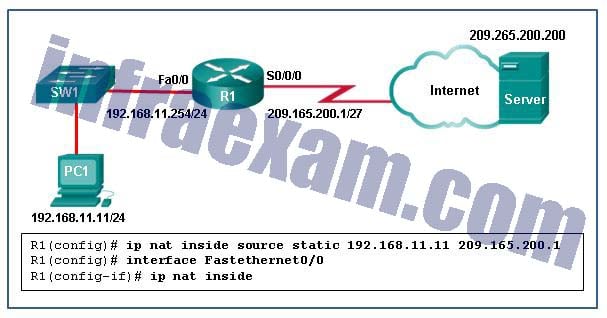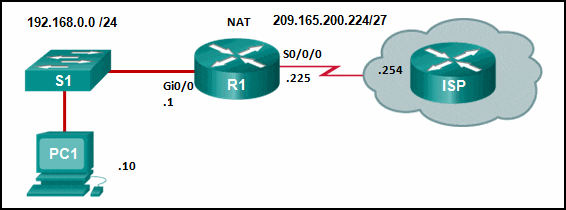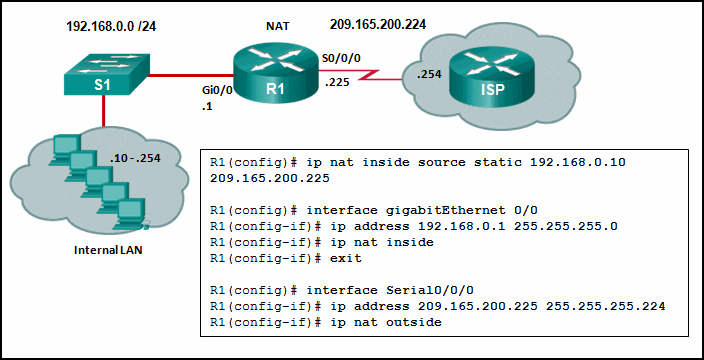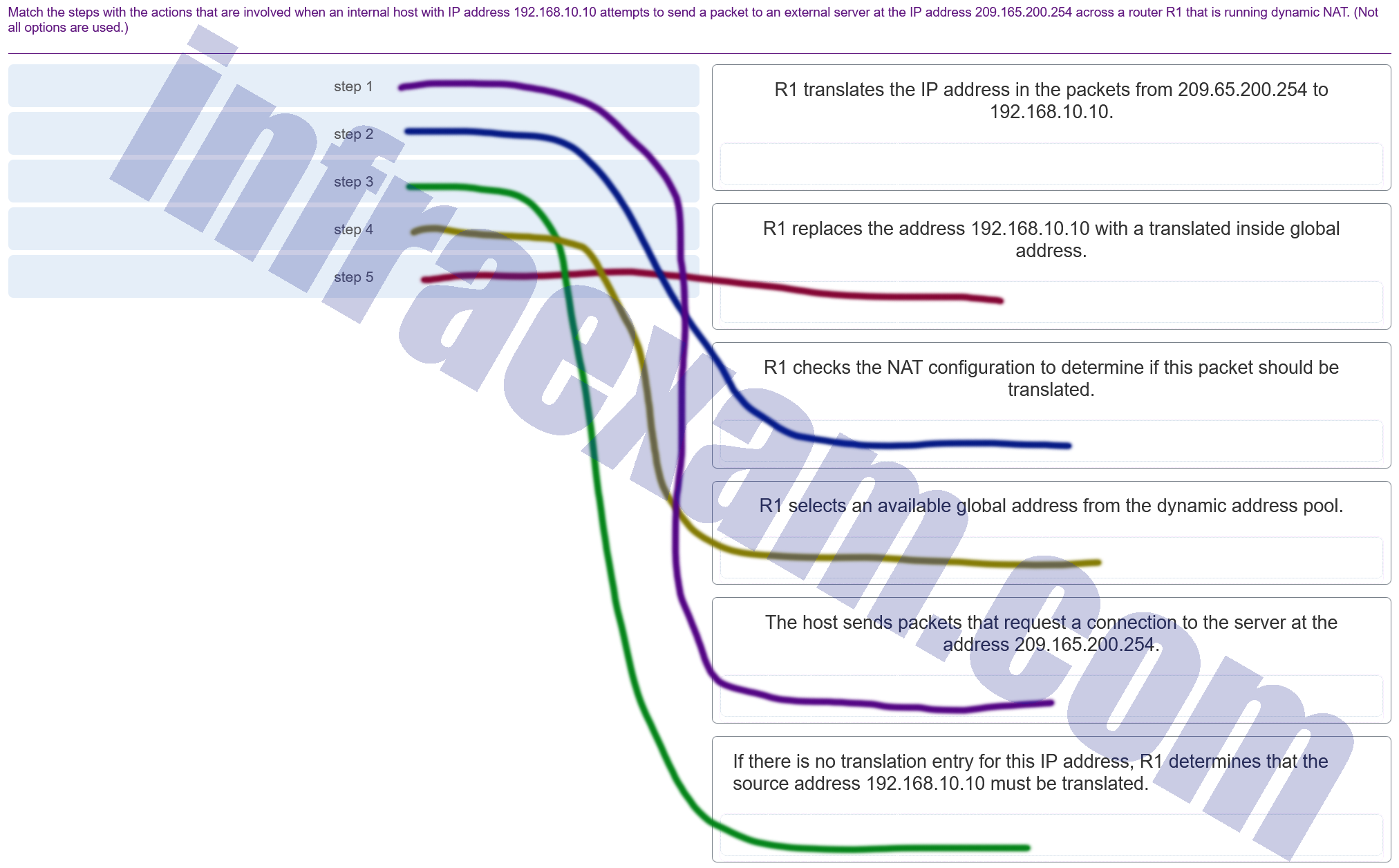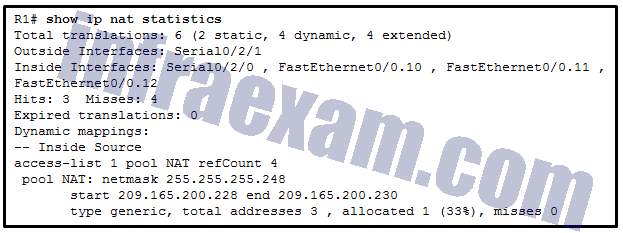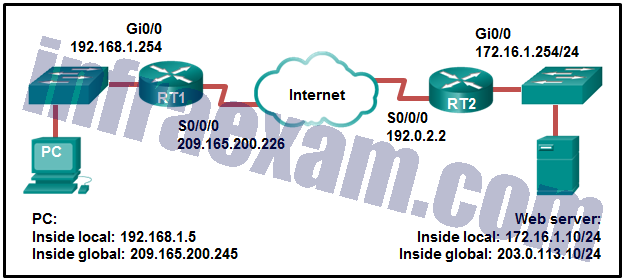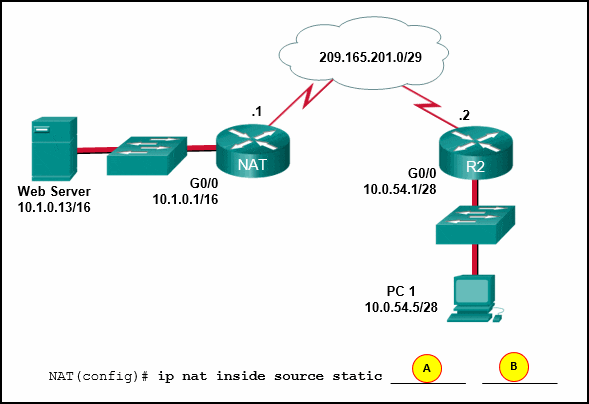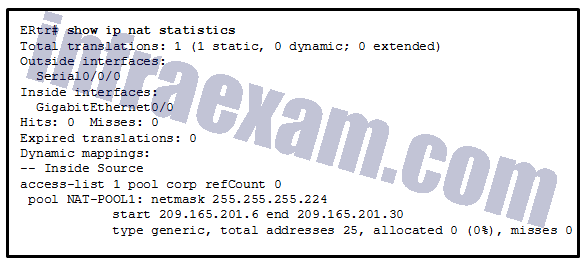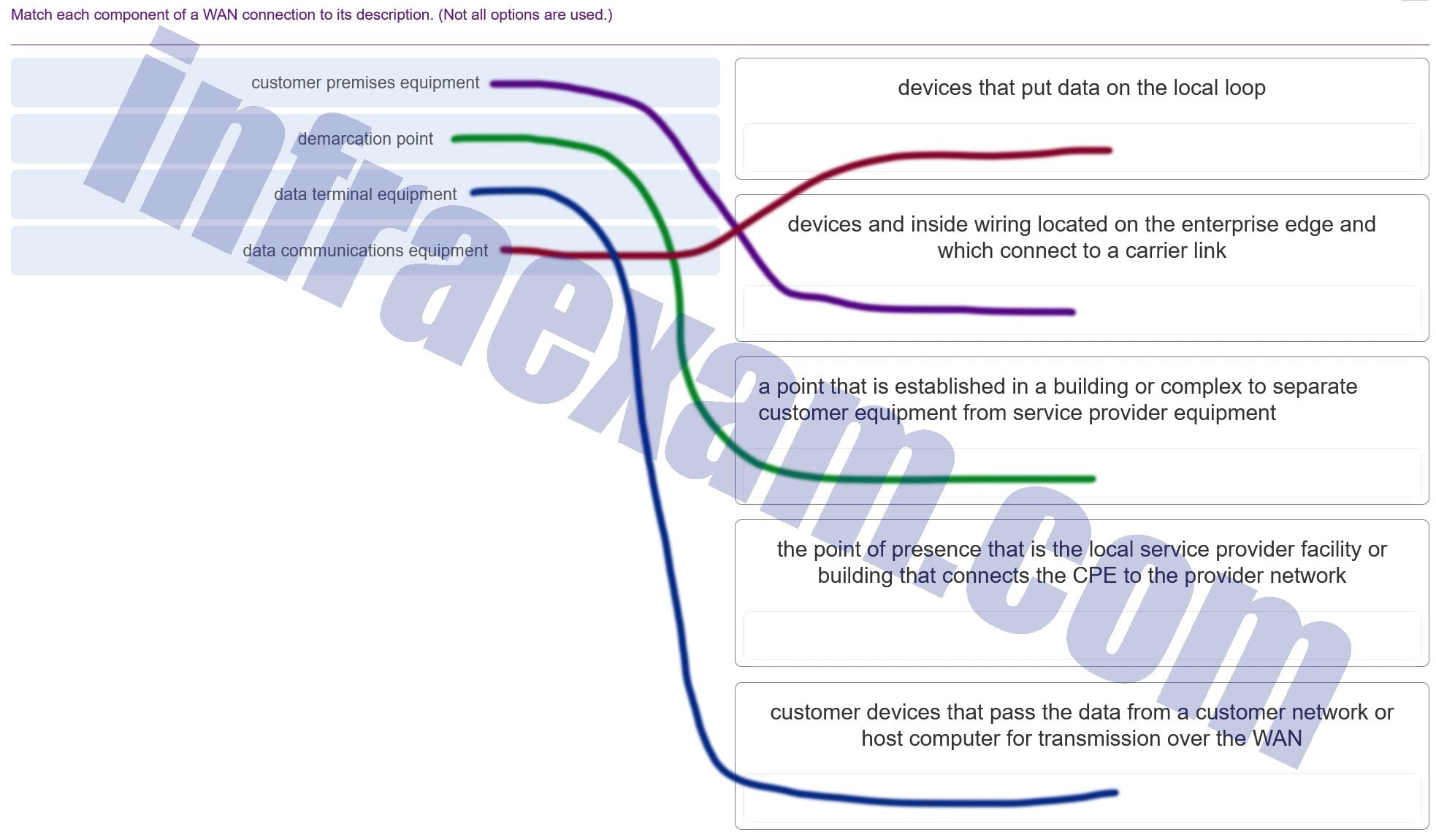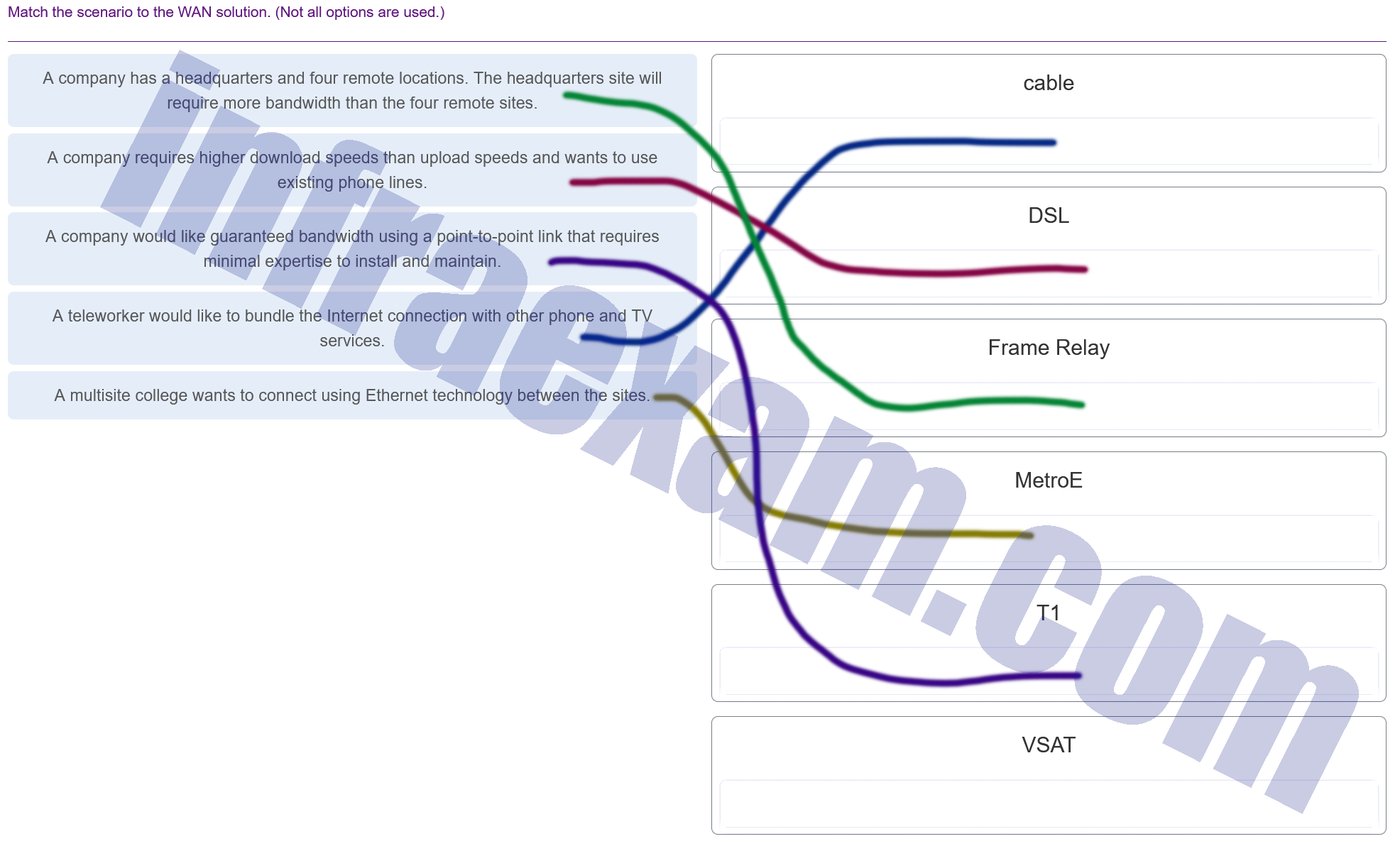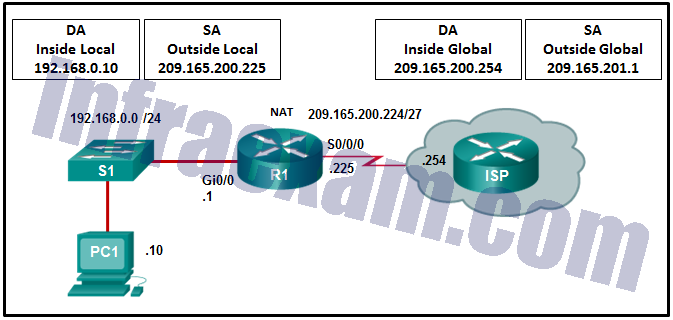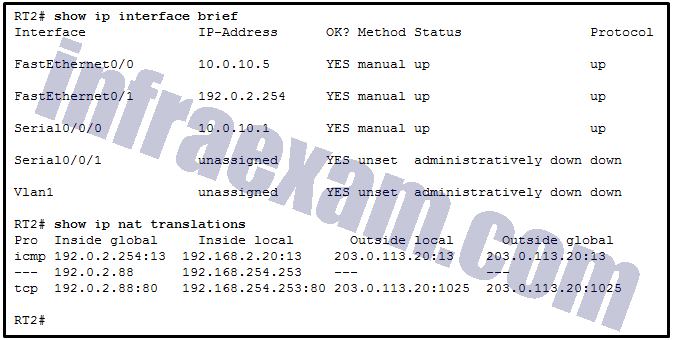Last Updated on February 1, 2021 by Admin
CCNA3 v7 – ENSA – Modules 6 – 8: WAN Concepts Exam Answers Full 100% 2020
Cisco Netacad ENSA Version 7.00 CCNA 3 v7 Modules 6 – 8: WAN Concepts Exam Answers 2020 2021 – Enterprise Networking, Security, and Automation
-
Refer to the exhibit. What has to be done in order to complete the static NAT configuration on R1?
- R1 should be configured with the command ip nat inside source static 209.165.200.1 192.168.11.11 .
- R1 should be configured with the command ip nat inside source static 209.165.200.200 192.168.11.11 .
- Interface S0/0/0 should be configured with the command ip nat outside .
- Interface Fa0/0 should be configured with the command no ip nat inside .
Answers Explanation & Hints: In order for NAT translations to work properly, both an inside and outside interface must be configured for NAT translation on the router.
-
Refer to the exhibit. A network administrator has configured R2 for PAT. Why is the configuration incorrect?
- The static NAT entry is missing.
- NAT-POOL2 is bound to the wrong ACL.
- The ACL does not define the list of addresses to be translated.
- The overload keyword should not have been applied.
Answers Explanation & Hints: In the exhibit, NAT-POOL 2 is bound to ACL 100, but it should be bound to the configured ACL 1. This will cause PAT to fail. 100, but it should be bound to the configured ACL 1. This will cause PAT to fail.
-
Refer to the exhibit. From the perspective of R1, the NAT router, which address is the inside global address?
- 192.168.0.1
- 192.168.0.10
- 209.165.200.225
- 209.165.200.254
Answers Explanation & Hints: There are four types of addresses in NAT terminology.
Inside local address
Inside global address
Outside local address
Outside global address
The inside global address of PC1 is the address that the ISP sees as the source address of packets, which in this example is the IP address on the serial interface of R1, 209.165.200.224.
-
Refer to the exhibit. Given the commands as shown, how many hosts on the internal LAN off R1 can have simultaneous NAT translations on R1?
- 1
- 10
- 244
- 255
Answers Explanation & Hints: The NAT configuration on R1 is static NAT which translates a single inside IP address, 192.168.0.10 into a single public IP address, 209.165.200.255. If more hosts need translation, then a NAT pool of inside global address or overloading should be configured.
-
Match the steps with the actions that are involved when an internal host with IP address 192.168.10.10 attempts to send a packet to an external server at the IP address 209.165.200.254 across a router R1 that is running dynamic NAT. (Not all options are used.)
Answers Explanation & Hints: The translation of the IP addresses from 209.65.200.254 to 192.168.10.10 will take place when the reply comes back from the server.
-
What is a disadvantage when both sides of a communication use PAT?
- Host IPv4 addressing is complicated.
- End-to-end IPv4 traceability is lost.
- The flexibility of connections to the Internet is reduced.
- The security of the communication is negatively impacted.
Answers Explanation & Hints: With the use of NAT, especially PAT, end-to-end traceability is lost. This is because the host IP address in the packets during a communication is translated when it leaves and enters the network. With the use of NAT/PAT, both the flexibility of connections to the Internet and security are actually enhanced. Host IPv4 addressing is provided by DHCP and not related to NAT/PAT.
-
Refer to the exhibit. A network administrator has just configured address translation and is verifying the configuration. What three things can the administrator verify? (Choose three.)
- Address translation is working.
- Three addresses from the NAT pool are being used by hosts.
- The name of the NAT pool is refCount.
- A standard access list numbered 1 was used as part of the configuration process.
- Two types of NAT are enabled.
- One port on the router is not participating in the address translation.
Answers Explanation & Hints: The show ip nat statistics , show ip nat translations , and debug ip nat commands are useful in determining if NAT is working and and also useful in troubleshooting problems that are associated with NAT. NAT is working, as shown by the hits and misses count. Because there are four misses, a problem might be evident. The standard access list numbered 1 is being used and the translation pool is named NAT as evidenced by the last line of the output. Both static NAT and NAT overload are used as seen in the Total translations line.
-
Refer to the exhibit. NAT is configured on RT1 and RT2. The PC is sending a request to the web server. What IPv4 address is the source IP address in the packet between RT2 and the web server?
- 192.0.2.2
- 172.16.1.10
- 203.0.113.10
- 172.16.1.254
- 192.168.1.5
- 209.165.200.245
Answers Explanation & Hints: Because the packet is between RT2 and the web server, the source IP address is the inside global address of PC, 209.165.200.245.
-
Refer to the exhibit. Based on the output that is shown, what type of NAT has been implemented?
- dynamic NAT with a pool of two public IP addresses
- PAT using an external interface
- static NAT with one entry
- static NAT with a NAT pool
Answers Explanation & Hints: The output shows that there are two inside global addresses that are the same but that have different port numbers. The only time port numbers are displayed is when PAT is being used. The same output would be indicative of PAT that uses an address pool. PAT with an address pool is appropriate when more than 4,000 simultaneous translations are needed by the company.
-
In NAT terms, what address type refers to the globally routable IPv4 address of a destination host on the Internet?
- inside global
- outside local
- outside global
- inside local
Answers Explanation & Hints: From the perspective of a NAT device, inside global addresses are used by external users to reach internal hosts. Inside local addresses are the addresses assigned to internal hosts. Outside global addresses are the addresses of destinations on the external network. Outside local addresses are the actual private addresses of destination hosts behind other NAT devices.
-
Refer to the exhibit. From the perspective of users behind the NAT router, what type of NAT address is 209.165.201.1?
- outside global
- outside local
- inside local
- inside global
Answers Explanation & Hints: From the perspective of users behind NAT, inside global addresses are used by external users to reach internal hosts. Inside local addresses are the addresses assigned to internal hosts. Outside global addresses are the addresses of destinations on the external network. Outside local addresses are the actual private addresses of destination hosts behind other NAT devices.
-
Refer to the exhibit. Static NAT is being configured to allow PC 1 access to the web server on the internal network. What two addresses are needed in place of A and B to complete the static NAT configuration? (Choose two.)
- A = 209.165.201.2
- A = 10.1.0.13
- B = 209.165.201.1
- B = 209.165.201.7
- B = 10.0.254.5
Answers Explanation & Hints: Static NAT is a one-to-one mapping between an inside local address and an inside global address. By using static NAT, external devices can initiate connections to internal devices by using the inside global addresses. The NAT devices will translate the inside global address to the inside local address of the target host.
-
What is the purpose of the overload keyword in the ip nat inside source list 1 pool NAT_POOL overload command?
- It allows many inside hosts to share one or a few inside global addresses.
- It allows a pool of inside global addresses to be used by internal hosts.
- It allows external hosts to initiate sessions with internal hosts.
- It allows a list of internal hosts to communicate with a specific group of external hosts.
Answers Explanation & Hints: Dynamic NAT uses a pool of inside global addresses that are assigned to outgoing sessions. If there are more internal hosts than public addresses in the pool, then an administrator can enable port address translation with the addition of the overload keyword. With port address translation, many internal hosts can share a single inside global address because the NAT device will track the individual sessions by Layer 4 port number.
-
Refer to the exhibit. Which source address is being used by router R1 for packets being forwarded to the Internet?
- 198.51.100.3
- 209.165.202.141
- 10.6.15.2
- 209.165.200.225
Answers Explanation & Hints: The source address for packets forwarded by the router to the Internet will be the inside global address of 209.165.200.225. This is the address that the internal addresses from the 10.6.15.0 network will be translated to by NAT.
-
What two addresses are specified in a static NAT configuration?
- the inside local and the inside global
- the inside global and the outside local
- the inside local and the outside global
- the outside global and the outside local
Answers Explanation & Hints: Static NAT configuration specifies a single inside local address and a single inside global address.
-
Refer to the exhibit. The NAT configuration applied to the router is as follows:
ERtr(config)# access-list 1 permit 10.0.0.0 0.255.255.255 ERtr(config)# ip nat pool corp 209.165.201.6 209.165.201.30 netmask 255.255.255.224 ERtr(config)# ip nat inside source list 1 pool corp overload ERtr(config)# ip nat inside source static 10.10.10.55 209.165.201.4 ERtr(config)# interface gigabitethernet 0/0 ERtr(config-if)# ip nat inside ERtr(config-if)# interface serial 0/0/0 ERtr(config-if)# ip nat outside
Based on the configuration and the output shown, what can be determined about the NAT status within the organization?
- NAT is working.
- Static NAT is working, but dynamic NAT is not.
- Dynamic NAT is working, but static NAT is not.
- Not enough information is given to determine if both static and dynamic NAT are working.
Answers Explanation & Hints: There is not enough information given because the router might not be attached to the network yet, the interfaces might not have IP addresses assigned yet, or the command could have been issued in the middle of the night. The output does match the given configuration, so no typographical errors were made when the NAT commands were entered.
-
Refer to the exhibit. Which two statements are correct based on the output as shown in the exhibit? (Choose two.)
- The output is the result of the show ip nat translations command.
- The host with the address 209.165.200.235 will respond to requests by using a source address of 192.168.10.10.
- The host with the address 209.165.200.235 will respond to requests by using a source address of 209.165.200.235.
- Traffic with the destination address of a public web server will be sourced from the IP of 192.168.1.10.
- The output is the result of the show ip nat statistics command.
Answers Explanation & Hints: The output displayed in the exhibit is the result of the show ip nat translations command. Static NAT entries are always present in the NAT table, while dynamic entries will eventually time out.
-
Which situation describes data transmissions over a WAN connection?
- An employee prints a file through a networked printer that is located in another building.
- A manager sends an email to all employees in the department with offices that are located in several buildings.
- An employee shares a database file with a co-worker who is located in a branch office on the other side of the city.
- A network administrator in the office remotely accesses a web server that is located in the data center at the edge of the campus.
Answers Explanation & Hints: When two offices across a city are communicating , it is most likely that the data transmissions are over some type of WAN connection. Data communications within a campus are typically over LAN connections.
-
A company is considering updating the campus WAN connection. Which two WAN options are examples of the private WAN architecture? (Choose two.)
- cable
- leased line
- Ethernet WAN
- municipal Wi-Fi
- digital subscriber line
Answers Explanation & Hints: An organization can connect to a WAN through basic two options:
Private WAN infrastructure – such as dedicated point-to-point leased lines, PSTN, ISDN, Ethernet WAN, ATM, or Frame Relay
Public WAN infrastructure – such as digital subscriber line (DSL), cable, satellite access, municipal Wi-Fi, WiMAX, or wireless cellular including 3G/4G
-
Match each component of a WAN connection to its description. (Not all options are used.)
-
Which two technologies are categorized as private WAN infrastructures? (Choose two.)
- cable
- DSL
- Frame Relay
- MetroE
- VPN
Answers Explanation & Hints: Private WAN technologies include leased lines, dialup, ISDN, Frame Relay, ATM, Ethernet WAN (an example is MetroE), MPLS, and VSAT.
-
Which network scenario will require the use of a WAN?
- Employee workstations need to obtain dynamically assigned IP addresses.
- Employees need to connect to the corporate email server through a VPN while traveling.
- Employees in the branch office need to share files with the headquarters office that is located in a separate building on the same campus network.
- Employees need to access web pages that are hosted on the corporate web servers in the DMZ within their building.
Answers Explanation & Hints: When traveling employees need to connect to a corporate email server through a WAN connection, the VPN will create a secure tunnel between an employee laptop and the corporate network over the WAN connection. Obtaining dynamic IP addresses through DHCP is a function of LAN communication. Sharing files among separate buildings on a corporate campus is accomplished through the LAN infrastructure. A DMZ is a protected network inside the corporate LAN infrastructure.
-
Match the scenario to the WAN solution. (Not all options are used.)
-
Which circumstance would result in an enterprise deciding to implement a corporate WAN?
- when its employees become distributed across many branch locations
- when the network will span multiple buildings
- when the number of employees exceeds the capacity of the LAN
- when the enterprise decides to secure its corporate LAN
Answers Explanation & Hints: WANs cover a greater geographic area than LANs do, so having employees distributed across many locations would require the implementation of WAN technologies to connect those locations. Customers will access corporate web services via a public WAN that is implemented by a service provider, not by the enterprise itself. When employee numbers grow, the LAN has to expand as well. A WAN is not required unless the employees are in remote locations. LAN security is not related to the decision to implement a WAN.
-
What is the function of the Hashed Message Authentication Code (HMAC) algorithm in setting up an IPsec VPN?
- guarantees message integrity
- authenticates the IPsec peers
- protects IPsec keys during session negotiation
- creates a secure channel for key negotiation
Answers Explanation & Hints: The IPsec framework uses various protocols and algorithms to provide data confidentiality, data integrity, authentication, and secure key exchange. The Hashed Message Authentication Code (HMAC) is a data integrity algorithm that uses a hash value to guarantee the integrity of a message.
-
What algorithm is used with IPsec to provide data confidentiality?
- MD5
- Diffie-Hellman
- RSA
- AES
- SHA
Answers Explanation & Hints: The IPsec framework uses various protocols and algorithms to provide data confidentiality, data integrity, authentication, and secure key exchange. Two popular algorithms that are used to ensure that data is not intercepted and modified (data integrity) are MD5 and SHA. AES is an encryption protocol and provides data confidentiality. DH (Diffie-Hellman) is an algorithm that is used for key exchange. RSA is an algorithm that is used for authentication.
-
What are two hashing algorithms used with IPsec AH to guarantee authenticity? (Choose two.)
- MD5
- SHA
- AES
- DH
- RSA
Answers Explanation & Hints: The IPsec framework uses various protocols and algorithms to provide data confidentiality, data integrity, authentication, and secure key exchange. Two popular algorithms used to ensure that data is not intercepted and modified (data integrity and authenticity) are MD5 and SHA.
-
What two algorithms can be part of an IPsec policy to provide encryption and hashing to protect interesting traffic? (Choose two.)
- AES
- SHA
- DH
- RSA
- PSK
Answers Explanation & Hints: The IPsec framework uses various protocols and algorithms to provide data confidentiality, data integrity, authentication, and secure key exchange. Two algorithms that can be used within an IPsec policy to protect interesting traffic are AES, which is an encryption protocol, and SHA, which is a hashing algorithm.
-
Which protocol creates a virtual point-to-point connection to tunnel unencrypted traffic between Cisco routers from a variety of protocols?
- OSPF
- IPsec
- IKE
- GRE
Answers Explanation & Hints: Generic Routing Encapsulation (GRE) is a tunneling protocol developed by Cisco that encapsulates multiprotocol traffic between remote Cisco routers. GRE does not encrypt data. OSPF is a open source routing protocol. IPsec is a suite of protocols that allow for the exchange of information that can be encrypted and verified. Internet Key Exchange (IKE) is a key management standard used with IPsec.
-
Which two end points can be on the other side of an ASA site-to-site VPN? (Choose two.)
- DSL switch
- router
- another ASA
- multilayer switch
- Frame Relay switch
Answers Explanation & Hints: In a site-to-site VPN, end hosts send and receive normal unencrypted TCP/IP traffic through a VPN terminating device, typically called a VPN gateway. A VPN gateway device could be a router or a firewall. A Cisco Adaptive Security Appliance (ASA) is a standalone firewall device that combines firewall, VPN concentrator, and intrusion prevention functionality into one software image.
-
Which VPN solution allows the use of a web browser to establish a secure, remote-access VPN tunnel to the ASA?
- clientless SSL
- client-based SSL
- site-to-site using a preshared key
- site-to-site using an ACL
Answers Explanation & Hints: When a web browser is used to securely access the corporate network, the browser must use a secure version of HTTP to provide SSL encryption. A VPN client is not required to be installed on the remote host, so a clientless SSL connection is used.
-
Which IPsec security function provides assurance that the data received via a VPN has not been modified in transit?
- confidentiality
- integrity
- authentication
- secure key exchange
Answers Explanation & Hints: Integrity is a function of IPsec and ensures data arrives unchanged at the destination through the use of a hash algorithm. Confidentiality is a function of IPsec and utilizes encryption to protect data transfers with a key. Authentication is a function of IPsec and provides specific access to users and devices with valid authentication factors. Secure key exchange is a function of IPsec and allows two peers to maintain their private key confidentiality while sharing their public key.
-
Which two technologies provide enterprise-managed VPN solutions? (Choose two.)
- Frame Relay
- site-to-site VPN
- Layer 2 MPLS VPN
- Layer 3 MPLS VPN
- remote access VPN
Answers Explanation & Hints: VPNs can be managed and deployed as either of two types:
Enterprise VPNs – Enterprise-managed VPNs are a common solution for securing enterprise traffic across the internet. Site-to-site and remote access VPNs are examples of enterprise managed VPNs.
Service Provider VPNs – Service provider managed VPNs are created and managed over the provider network. Layer 2 and Layer 3 MPLS are examples of service provider managed VPNs. Other legacy WAN solutions include Frame Relay and ATM VPNs.
-
Which two types of VPNs are examples of enterprise-managed remote access VPNs? (Choose two.)
- IPsec VPN
- clientless SSL VPN
- GRE over IPsec VPN
- client-based IPsec VPN
- IPsec Virtual Tunnel Interface VPN
Answers Explanation & Hints: Enterprise managed VPNs can be deployed in two configurations:
Remote Access VPN – This VPN is created dynamically when required to establish a secure connection between a client and a VPN server. Remote access VPNs include client-based IPsec VPNs and clientless SSL VPNs.
Site-to-site VPN – This VPN is created when interconnecting devices are preconfigured with information to establish a secure tunnel. VPN traffic is encrypted only between the interconnecting devices, and internal hosts have no knowledge that a VPN is used. Site-to-site VPNs include IPsec, GRE over IPsec, Cisco Dynamic Multipoint (DMVPN), and IPsec Virtual Tunnel Interface (VTI) VPNs.
-
Which is a requirement of a site-to-site VPN?
- It requires a client/server architecture.
- It requires the placement of a VPN server at the edge of the company network.
- It requires hosts to use VPN client software to encapsulate traffic.
- It requires a VPN gateway at each end of the tunnel to encrypt and decrypt traffic.
Answers Explanation & Hints: Site-to-site VPNs are static and are used to connect entire networks. Hosts have no knowledge of the VPN and send TCP/IP traffic to VPN gateways. The VPN gateway is responsible for encapsulating the traffic and forwarding it through the VPN tunnel to a peer gateway at the other end which decapsulates the traffic.
-
What is the function of the Diffie-Hellman algorithm within the IPsec framework?
- allows peers to exchange shared keys
- provides strong data encryption
- guarantees message integrity
- provides authentication
Answers Explanation & Hints: The IPsec framework uses various protocols and algorithms to provide data confidentiality, data integrity, authentication, and secure key exchange. DH (Diffie-Hellman) is an algorithm used for key exchange. DH is a public key exchange method that allows two IPsec peers to establish a shared secret key over an insecure channel.
-
What does NAT overloading use to track multiple internal hosts that use one inside global address?
- MAC addresses
- port numbers
- IP addresses
- autonomous system numbers
Answers Explanation & Hints: NAT overloading, also known as Port Address Translation (PAT), uses port numbers to differentiate between multiple internal hosts.
-
Refer to the exhibit. The PC is sending a packet to the Server on the remote network. Router R1 is performing NAT overload. From the perspective of the PC, match the NAT address type with the correct IP address. (Not all options are used.)
Answers Explanation & Hints: The inside local address is the private IP address of the source or the PC in this instance. The inside global address is the translated address of the source or the address as seen by the outside device. Since the PC is using the outside address of the R1 router, the inside global address is 192.0.2.1. The outside addressing is simply the address of the server or 203.0.113.5.
-
Refer to the exhibit. R1 is configured for static NAT. What IP address will Internet hosts use to reach PC1?
- 192.168.0.10
- 192.168.0.1
- 209.165.200.225
- 209.165.201.1
Answers Explanation & Hints: In static NAT a single inside local address, in this case 192.168.0.10, will be mapped to a single inside global address, in this case 209.165.200.225. Internet hosts will send packets to PC1 and use as a destination address the inside global address 209.165.200.225.
-
Refer to the exhibit. A network administrator is viewing the output from the command show ip nat translations . Which statement correctly describes the NAT translation that is occurring on router RT2?
- The traffic from a source IPv4 address of 192.0.2.88 is being translated by router RT2 to reach a destination IPv4 address of 192.168.254.253.
- The traffic from a source IPv4 address of 192.168.254.253 is being translated to 192.0.2.88 by means of static NAT.
- The traffic from a source IPv4 address of 192.168.2.20 is being translated by router RT2 to reach a destination IPv4 address of 192.0.2.254.
- The traffic from a source IPv4 public address that originates traffic on the internet would be able to reach private internal IPv4 addresses.
Answers Explanation & Hints: Because no outside local or outside global address is referenced, the traffic from a source IPv4 address of 192.168.254.253 is being translated to 192.0.2.88 by using static NAT. In the output from the command show ip nat translations , the inside local IP address of 192.168.2.20 is being translated into an outside IP address of 192.0.2.254 so that the traffic can cross the public network. A public IPv4 device can connect to the private IPv4 device 192.168.254.253 by targeting the destination IPv4 address of 192.0.2.88.
-
Which two WAN infrastructure services are examples of private connections? (Choose two.)
- T1/E1
- wireless
- DSL
- cable
- Frame Relay
Answers Explanation & Hints: Private WANs can use T1/E1, T3/E3, PSTN, ISDN, Metro Ethernet, MPLS, Frame Relay, ATM, or VSAT technology.
-
Which two statements about the relationship between LANs and WANs are true? (Choose two.)
- Both LANs and WANs connect end devices.
- WANs connect LANs at slower speed bandwidth than LANs connect their internal end devices.
- LANs connect multiple WANs together.
- WANs must be publicly-owned, but LANs can be owned by either public or private entities.
- WANs are typically operated through multiple ISPs, but LANs are typically operated by single organizations or individuals.
Answers Explanation & Hints: Although LANs and WANs can employ the same network media and intermediary devices, they serve very different areas and purposes. The administrative and geographical scope of a WAN is larger than that of a LAN. Bandwidth speeds are slower on WANs because of their increased complexity. The Internet is a network of networks, which can function under either public or private management.
-
Which statement describes an important characteristic of a site-to-site VPN?
- It must be statically set up.
- It is ideally suited for use by mobile workers.
- It requires using a VPN client on the host PC.
- It is commonly implemented over dialup and cable modem networks.
- After the initial connection is established, it can dynamically change connection information.
Answers Explanation & Hints: A site-to-site VPN is created between the network devices of two separate networks. The VPN is static and stays established. The internal hosts of the two networks have no knowledge of the VPN.
-
How is “tunneling” accomplished in a VPN?
- New headers from one or more VPN protocols encapsulate the original packets.
- All packets between two hosts are assigned to a single physical medium to ensure that the packets are kept private.
- Packets are disguised to look like other types of traffic so that they will be ignored by potential attackers.
- A dedicated circuit is established between the source and destination devices for the duration of the connection.
Answers Explanation & Hints: Packets in a VPN are encapsulated with the headers from one or more VPN protocols before being sent across the third party network. This is referred to as “tunneling”. These outer headers can be used to route the packets, authenticate the source, and prevent unauthorized users from reading the contents of the packets.
-
Which statement describes a VPN?
- VPNs use dedicated physical connections to transfer data between remote users.
- VPNs use logical connections to create public networks through the Internet.
- VPNs use open source virtualization software to create the tunnel through the Internet.
- VPNs use virtual connections to create a private network through a public network.
Answers Explanation & Hints: A VPN is a private network that is created over a public network. Instead of using dedicated physical connections, a VPN uses virtual connections routed through a public network between two network devices.
-
Open the PT Activity. Perform the tasks in the activity instructions and then answer the question.
What problem is causing PC-A to be unable to communicate with the Internet?
- The static route should not reference the interface, but the outside address instead.
- This router should be configured to use static NAT instead of PAT.
- The ip nat inside source command refers to the wrong interface.
- The access list used in the NAT process is referencing the wrong subnet.
- The NAT interfaces are not correctly assigned.
Answers Explanation & Hints: The output of show ip nat statistics shows that the inside interface is FastEthernet0/0 but that no interface has been designated as the outside interface. This can be fixed by adding the command ip nat outside to interface Serial0/0/0.
-
What type of address is 10.131.48.7?
- private
- public
-
What type of address is 10.19.6.7?
- private
- public
-
What type of address is 192.168.7.98?
- private
- public
-
What type of address is 64.100.190.189?
- public
- private
-
What type of address is 198.133.219.148?
- public
- private
-
What type of address is 128.107.240.239?
- public
- private
-
What type of address is 64.101.198.197?
- public
- private
-
What type of address is 10.100.34.34?
- private
- public
-
What type of address is 10.100.126.126?
- private
- public
-
What type of address is 192.168.7.126?
- private
- public
-
Which type of VPN involves passenger, carrier, and transport protocols?
- GRE over IPsec
- IPsec virtual tunnel interface
- MPLS VPN
- dynamic multipoint VPN
-
Which type of VPN supports multiple sites by applying configurations to virtual interfaces instead of physical interfaces?
- IPsec virtual tunnel interface
- dynamic multipoint VPN
- MPLS VPN
- GRE over IPsec
-
Which type of VPN connects using the Transport Layer Security (TLS) feature?
- SSL VPN
- GRE over IPsec
- dynamic multipoint VPN
- IPsec virtual tunnel interface
-
Which type of VPN connects using the Transport Layer Security (TLS) feature?
- SSL VPN
- MPLS VPN
- IPsec virtual tunnel interface
- dynamic multipoint VPN
-
Which type of VPN has both Layer 2 and Layer 3 implementations?
- MPLS VPN
- IPsec virtual tunnel interface
- dynamic multipoint VPN
- GRE over IPsec
-
Which type of VPN has both Layer 2 and Layer 3 implementations?
- MPLS VPN
- SSL VPN
- GRE over IPsec
- dynamic multipoint VPN
-
Which type of VPN allows multicast and broadcast traffic over a secure site-to-site VPN?
- GRE over IPsec
- SSL VPN
- dynamic multipoint VPN
- IPsec virtual tunnel interface
-
Which type of VPN uses the public key infrastructure and digital certificates?
- SSL VPN
- GRE over IPsec
- dynamic multipoint VPN
- IPsec virtual tunnel interface
-
Which type of VPN involves a nonsecure tunneling protocol being encapsulated by IPsec?
- GRE over IPsec
- dynamic multipoint VPN
- IPsec virtual tunnel interface
- SSL
-
Which type of VPN routes packets through virtual tunnel interfaces for encryption and forwarding?
- IPsec virtual tunnel interface
- MPLS VPN
- dynamic multipoint VPN
- GRE over IPsec
